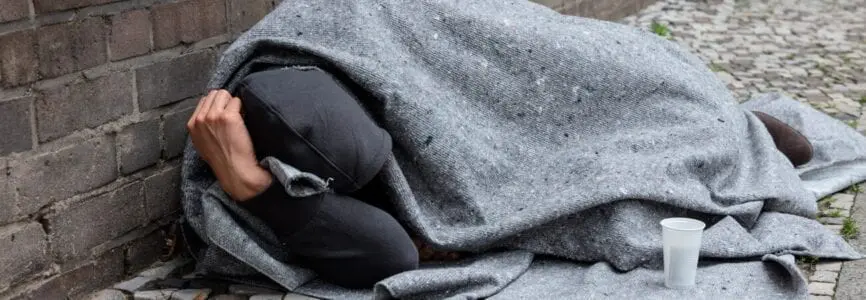Bioethics Forum Essay
After Hurricane Harvey, Injustice in Houston
Hurricane Harvey dissipated in September, but much of the destruction that it wreaked on Texas and Louisiana remains. When addressing residential concerns, disaster relief officials prioritize the newly homeless over the chronically homeless, choosing to protect the previously privileged over the unprivileged. These benefits range from housing assistance to medical aid, impacting every part of these people’s lives.
As a native Houstonian, I have watched homeless people weather storm after storm. I must ask, is it fair to ignore the most marginalized people in a major crisis? Before Harvey struck Texas, police officers and outreach teams encouraged homeless people to go to shelters, but many stayed on the streets and under freeways. Considering that Mayor Sylvester Turner used legal means to discourage long-term camping and promote safe housing, there were options that he could have taken to ensure the safety of his constituents. City officials could have evacuated homeless encampments because of the serious health hazard posed by Hurricane Harvey, but they chose not to.
Other cities and states have treated their homeless populations worse. In Florida, homeless people said they were segregated and shamed in several Hurricane Irma evacuation centers. At some shelters, homeless people were turned away or denied food. The cost to the physical and mental health of homeless people is tremendous. A year after Hurricane Katrina, nearly half of the children in a study of 329 families showed signs of post-traumatic stress disorder. Another study discovered that mental and physical illnesses, including PTSD, were common among Katrina survivors who at least had homes during the flood. Homeless people are particularly vulnerable because they suffer from higher rates of mental illness and substance abuse than the general population.
Houston’s homeless community continues to struggle for survival. Part of the problem is that the Federal Emergency Management Agency prioritizes housing and other aid for newly homeless storm victims. A FEMA spokeswoman told Reuters, “If an individual was homeless pre-disaster, they may not be considered for Housing Assistance and Other Needs Assistance, which both require successful verification of pre-disaster occupancy.” Other Needs Assistance covers everything from medical and dental costs to cleaning items. Without medical assistance, homeless people will lose access to prescription drugs that they may desperately need for mental health or chronic illnesses.
Homeless people, exposed to strong winds and floods nonstop for days, suffered greater harm than people with homes. By refusing to help them survive, FEMA is ultimately perpetuating a vicious cycle of inequality in which homeless people are marginalized.
Disaster relief officials must always triage resources because resources are limited. But disaster relief resources seem insufficient, and lives are at stake. The Department of Homeland Security cut its budget request for FEMA from approximately $17 billion in 2017 to $15.5 billion in 2018. Texas Governor Greg Abbott estimated that the state needed more than $180 billion for storm recovery. However, the U.S. Department of Housing and Urban Development has sent only $5 billion, and FEMA has spent about $1.4 billion. Texas officials have not happed into the state’s “rainy day fund” of around $10 billion.
We can already guess how the story in Houston may unfold. After Hurricane Katrina, many chronically homeless residents of New Orleans were unable to find medical treatment for their illnesses. Some of them may have died after they returned to the city, lost and forgotten. In the future, cities and states should prepare comprehensive plans that consider the safety of homeless people. In Houston, where widespread flooding has become an annual problem, further preparation is necessary. Everyone impacted by a natural disaster deserves help, regardless of their previous circumstances.
John Lin is a senior at William P. Clements High School in Sugar Land, Tx. He has worked with post-Harvey recovery programs and organized donation drives for hurricane victims.














The real issue surrounding each community’s homelessness is our nation’s progressive decline of each community’s level of Social Capital. Furthermore, there is no nationally structured, regionally promoted and locally managed means to promote the community-centric COMMON GOOD for each citizen. This is most clearly demonstrated by the efficiency and effectiveness problems associated with each citizen’s healthcare. Our nation is alone among the OECD nation’s with a worsening maternal mortality rate, for 25 years now. And. the other OECD nation’s ‘health spending’ clusters at 12-13% of their GDP while ours is more than 18%. The difference between 13% and 18% for our economy in 2016 was $1 Trillion. These issues will not be resolved without a renewed, community by community means to increase its level of Social Capital as the basis for a greater commitment to its own COMMON GOOD.
Try on the following definition of Social Capital: the attributes of Trust, Cooperation and Reciprocity applied during a community’s social discourse for resolving the social dilemmas encountered by each citizen during their participation in the community’s civil life that will occur more prominently when generational Caring Relationships are increasingly prevalent throughout the networks of the community’s citizens, especially the ‘neighborhood network’ of each citizen’s FAMILY.
There is no reason to believe that any variation within our nation’s current healthcare reform will solve the current loss of social mobility opportunities for each citizen’s Family and their attendant Unstable Health. Its all best described by Robert D. Putman’s book “OUR KIDS The American Dream in Crisis” 2015.